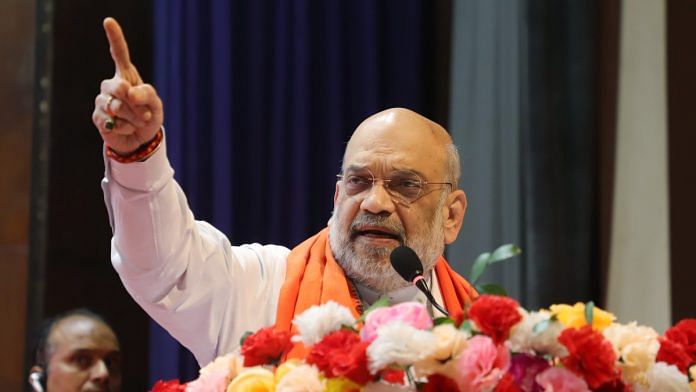New Delhi: Confirming the implementation of the announcement he had made last month on ending the Free Movement Regime (FMR) with Myanmar, Union Home Minister Amit Shah announced Tuesday that the entire length of the international border along Myanmar will be fenced.
Shah had announced that the Narendra Modi-led National Democratic Alliance (NDA) government was working to end the FMR that allowed any resident within 16 kilometres on either side of the India-Myanmar border to cross over and stay on the other side for up to two weeks after showing a border pass.
“I want to tell my friends in Assam that the Narendra Modi government has decided to fence India’s open border along with Myanmar just like we have fenced the country’s border with Bangladesh,” Shah had said in Guwahati last month. “The government is also reconsidering India’s Free Movement Regime agreement with Myanmar and will soon end the free movement into India.”
Shah has now said the government will fence the entire 1,643-kilometre-long border and will construct a patrol track to ensure better surveillance. He added that there is a plan to use a hybrid surveillance system (HSS) and two pilot projects — covering 1 kilometre of border each in Arunachal Pradesh and Manipur — are already underway.
Giving specific details on the conflict-torn Manipur, Shah said that a 10-kilometre stretch in the border town of Moreh has already been fenced so far and that fencing work for an additional 20 kilometres has been approved and the work will start very soon.
Former Director General of Police and Home Secretary of Manipur, B.L. Vohra said that the fencing of the international border was feasible and that it would lead to a better situation in the state in terms of controlling the influx of insurgents.
He said that in addition to the tribal population traversing the border at Moreh in Manipur, insurgents were also infiltrating from various other locations. These areas served as routes for smugglers to traffic drugs, arms, and ammunition, resulting in a significant disruption to the law-and-order situation, not only in Manipur but also in other Northeastern states.
“This area forms a part of the golden triangle and hence there is a lot of supply of drugs and ammunition. Insurgents’ entry through the porous borders and at areas where there are no checkpoints were quite detrimental to India’s interest and hence fencing is completely worth the efforts and was long overdue,” Vohra told ThePrint.
Also read: India-Myanmar share an imperfect, complex history. Insurgency, drug trade led to permit system
Must win over tribals
Pushpita Das, Research Fellow at Manohar Parrikar Institute for Defence Studies and Analyses told ThePrint that the idea of free movement of tribals on either side of the border began as far back as in the 1950s but it changed over time and there were restrictions imposed on movement up to a certain distance inside border on both sides.
However, that was not maintained because tribals did not accept the restrictions and that is where the challenge will come from even this time because the tribals consider the population on the other side of the border as their own, she added.
Additionally, Das said that as the FMR has been formally ratified by both the Indian and Myanmar governments, fencing can’t be done unilaterally and Myanmar, too, has to agree with it.
She said that when there was fencing at Moreh, Myanmar opposed the idea citing disputed territories at certain points such as pillars and villages but then the government agreed to fence the border at 10 metres inside the demarcation line.
The cost of fencing and compliance by the tribal population will be another issue. Das suggested that the cost of fencing the entire Myanmar border will outweigh the benefits it could bring, at least initially, and hence tribals will have to be won over for any successful outcome of this move to end the free movement of tribal people.
(Edited by Zinnia Ray Chaudhuri)
Also read: Govt should reconsider India-Myanmar border fence. Costs & benefits don’t justify it



